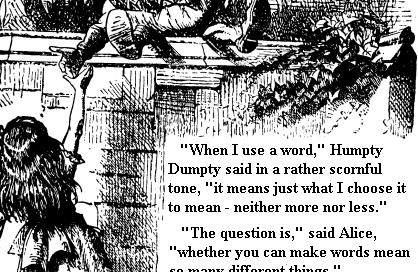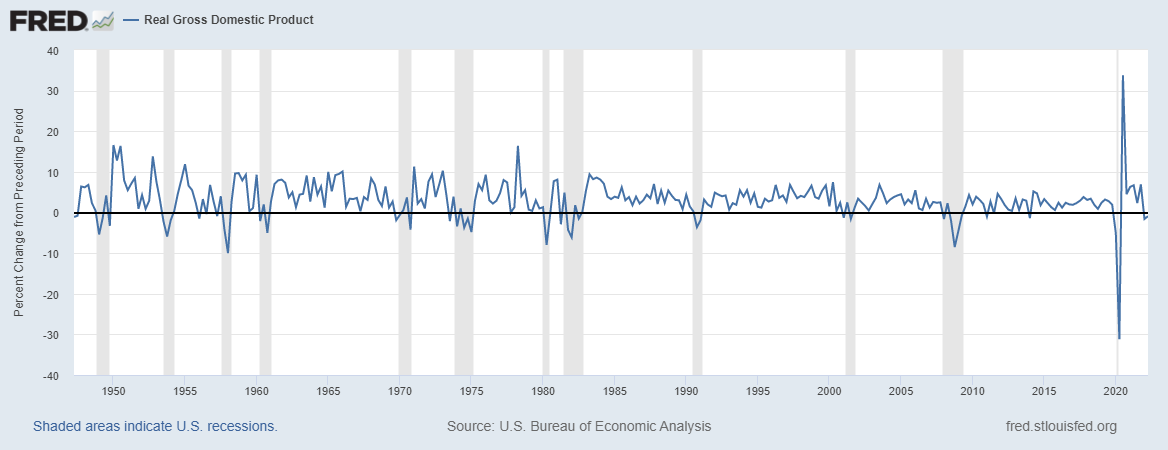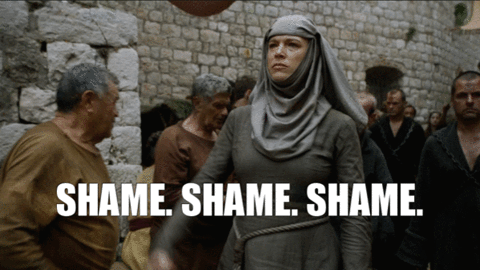On recessions: definitions, Humpty Dumpty, and out-sourcing decision-making
‘The question is,’ said Humpty Dumpty, ‘which is to be master–that’s all’
Just got this breaking news:
Stock futures slide after GDP contracts for a second time, raising recession fears
Stock futures fell on Thursday after the latest GDP reading showed a slight decrease, adding to investors’ worries about an economic recession.
Futures tied to the Dow Jones Industrial Average slipped 61 points, or 0.2%. S&P 500 futures lost 0.2%, and Nasdaq 100 futures dropped 0.4%.
U.S. economic growth fell 0.9% in the second quarter, the Bureau of Economic Analysis reported. The Dow Jones estimate was for a gain of 0.3%. First-quarter GDP declined by 1.6%.
Investors have grown increasingly concerned in recent months that the Fed’s attempts to tame surging prices would move the economy closer to a recession. Many characterize a recession as having two back-to-back negative quarters of economic growth. It’s more nuanced than that though, according to the National Bureau of Economic Research, the official arbiter of recessions, which considers several additional factors.
So, you may wonder who put the NBER in charge of naming recessions (I know I did), and then who is fooled by the crap of whatever people will call this.
So let us have an interlude, and then let me graph a few things.
Twitter interlude

Humpty dumpty is correct, however….
And now I’m going to jump into the realm of fantasy and mathematics, which aren’t necessarily different… except they are.
A favorite passage from Through the Looking Glass is this:
‘…and that shows that there are three hundred and sixty-four days when you might get un-birthday presents––‘
‘Certainly,’ said Alice.
‘And only one for birthday presents, you know. There’s glory for you!’
‘I don’t know what you mean by “glory”,’ Alice said.
‘Humpty Dumpty smiled contemptuously. ‘Of course you don’t–till I tell you. I meant “there’s a nice knock-down argument for you!”’
‘But “glory” doesn’t mean “a nice knock-down argument”, Alice objected.
‘When I use a word,’ Humpty Dumpty said in rather a scornful tone, ‘it means just what I choose it to mean–neither more nor less.’
‘The question is,’ said Alice, ‘whether you can make words mean different things–that’s all.’
‘The question is,’ said Humpty Dumpty, ‘which is to be master–that’s all’
In mathematics, we don’t have an issue that one can take a term, and give it whatever definition you want. But you need to have it be well-defined, and, most importantly, you have to define the term before you start using it in discourse.
The big problem in regular mathematics is that we often use terms that are normal terms in English, like set or group, and we use these terms in math in very specific ways in our proofs. I ran into this problem in trying to teach about different types of infinity. (“But infinity is infinity!”)
Nobody really likes a “I know it when I see it!” type of definition for anything.
People especially hate it when you change the definition in the middle of a discussion so that you can win that nice knock-down argument.
I mean, win that glory.
Ain’t that glorious?
But this is much ado about nothing.

A quick look at GDP trend
So enough of that hilarity. Let’s look at what current graphs of recessions v. GDP growth look like… and how dishonest a new “definition” might be. It’s not really a new definition at all I found.

So I went to FRED, as one does, to get economic data. I grabbed A191RL1Q225SBEA, better known as the Real Domestic Product, Percent Change from Preceding Period,Seasonally Adjusted Annual Rate.
This is the graph you get, and the shading indicates the “official recessions”.
Here is the list of official recessions as per FRED:, and I looked as to whether the data set showed two quarters of decreases in that period. Here is NBER’s own page as well if you want to cross-reference, which agrees with FRED’s record.
Given that data set, I noticed that no, the NBER doesn’t exactly use the two consecutive quarter definition of real GDP decrease for “recession”, and that sometimes one had a quarter of slight growth in the middle of a recessionary run (and then a quarter of retraction). It’s just a shortcut.
I noticed there were periods of negative real GDP growth…. and NBER didn’t label it as a recession.
At the very beginning of the series, if you squint, you will see the first two quarters are negative — the first two quarters had annualized growth rates of -1.1% and -0.8%. Not labeled as a recession.
Note that the first quarter of 2022 was -1.6% and the second quarter at -0.9%. That’s almost exactly the same pattern.
Guys, these are no great shakes.
Let me go to a different extreme. Sometimes, the negative growth rate is so large, that you can put in one quarter of positive growth, but it’s so anemic, that you’re still in a recession. You can see it in the graph, but let me give you the numbers. That happened in multiple recessions, but let me just pick one from the 1970s.
Recession: November 1973 (1973Q4) – March 1975 (1975Q1)
So let’s check the GDP annualized growth over those quarters: -3.4%, 1.0%, -3.7%, -1.5%, -4.8%
It started with a negative/positive pattern, not two consecutive negative quarters.
And I see that Mish has pointed out that no, the definition of recession hasn’t actually been changed.
GDP is -0.9 Percent, Second Straight Decline, But a Recession Did Not Start in Q1
GDP declined for two quarters but Real Final Sales (RFS) did not. RFS is the true bottom line estimate for the economy. The baseline number includes inventory adjustments that net to zero over time.
Unless the BEA revises RFS into negative territory, don’t expect a Q1 recession declaration.
The National Bureau of Economic Research (NBER), is the official arbiter of recessions. It is highly unlikely to declare a recession starting in the first quarter with RFS at +1.1 percent.
I just did this quickly during lunch. I did not note all the variations from the two consecutive quarters definition, but if you look at the begin/end dates, it never quite exactly matches in most cases for NBER. It’s just so you have a quick way to get a result instead of having to wait until months after the recession actually ends that you know when it occurred.
So what’s the big deal?
Yes, a lot of it is politics, but the main thing is waiting around for NBER to give us a ruling….
People want quick info. It’s bad enough we have to wait for 6 months for information, and then we have to wait for a bunch of eggheads to do more analysis! The audacity!
(but it is mostly politics)
I can sit around and wait for someone to give me a file with dates for recessions going back into the 19th century so I can do economic research. The minimum period I like looking at is 10 years. I much prefer 20 years, and when it comes to economic cycles, I want 50 years. At least.
Now that I realize that there is a kind of “magic mix” in declaring recessions, I think I would rather not use these binary yes/no indicator variables (which often mess up models anyway); I think I will just use these more continuous inputs of GDP growth rates instead of whether it’s a recession or not.
But again, it’s really about politics.
We know that many people want to say it is or isn’t a recession in political ads for this election cycle.
But unfortunately, that’s not the only thing.
Evidently, too many politicians have outsourced the decision-making they should be doing by writing into legislation some automatic triggers as to whether it’s a recession. So rather than actually have to pass new legislation to extend deadlines, they have it built into legislation that if it’s an official recession, certain deadlines are automatically extended. Easy-peasy.
And if a recession is not declared…. well, not their problem, I guess.
So, frankly, I have no particular criticism for the NBER behaving as they always have and doing the analysis they always do using the principles they always have. Keep on truckin’, y’all.
I do have a critique of both legislators and executives who outsource the decision-making they should be doing.
Do your jobs.
(Oh, and I will use shaded areas for a variety of purposes in my graphs. Most often it’s just to indicate whether the year is even or odd.)












“In mathematics, we don’t have an issue that one can take a term, and give it whatever definition you want.”
bUt DoN’t YoU kNoW tHaT 2+2 EqUaLs 5 iS jUsT a SoCiAL cOnStRuCt?